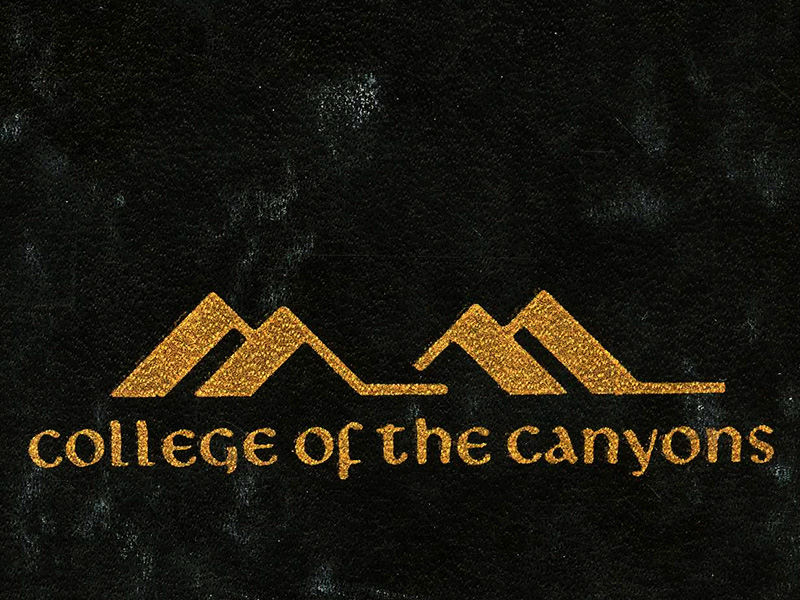|
|

1973 COC "Image" Yearbook.
College of the Canyons.
Valencia, California.
|
Yearbook Staff: Judith Conklin, Pat Smart, Colleen Andreasen, Terry Carlson, Marlene Van Eunen, Rick Signoretti, Cheryl Meramble, Michele Carmody, Rene LaRue, Kris Trageser, j Debbie Ellis, Ginni Bowen, Laurali Sails. Photographers: Johny Albrecht, Jerry Hornbeck, Bruce McKinney, Paulj Osterhues, Tim Quinn, David Sirchuk, Tom Quintana, Todd Barnett. Advisor: Anton Remenih
1973: The Year of the Big Bond Election This was a year of great expectations and comparable realizations for College of the Canyons. It was a fateful year of decision. COC was a wanted baby in 1967 when residents of this area voted overwhelmingly for their own community college. This college was launched so speedily m 1970 that it was called an "instant campus." But the college stopped growing at adolescence, one might say. It remained immature, architecturally speaking, with a motif students described as "early Stalag 13" (brown, relocatable, one-story structures as classrooms). COC also suffered from academic frustration for lack of growing room. What this young institution sorely needed was a permanent home large enough to provide for a steadily increasing enrollment and to serve as a cultural and recreational center for the entire community. In November 1972, state voters authorized a $160 million community college construction act with $11.2 million as COC's share — provided this district came up with about $2.5 million in matching funds. As Dr. Robert C. Rockwell, superintendent-president, put it, "It's a tremendous bargain." The Board of Trustees authorized an $8 million bond issue (to meet matching funds and pay for other construction the state could not pay for) and COC and the community galvanized into action. The bond election, which required a formidable two-thirds majority, was set for Feb. 6, 1973. Elisha Agajanian, Santa Clarita National Bank board chairman, and Blake V. Blakey, Newhall manager of the Anawalt Lumber & Materials Co., headed a group of 40 community leaders who organized a Citizens' Committee to Complete College of the Canyons. Staff and faculty members conducted numerous neighborhood meetings and spoke (on their own off-school time) at many rallies. A student committee registered voters not only on this campus but at other schools as well, and on election day provided transportation to the polls. Campus rallies also were held. The student newspaper, The Canyon Call, published a special election edition that was distributed to more than 18,000 residents as well as to the student body. Robert Berson, assistant superintendent, business services, coordinated the various efforts. These statistics so defied the trend and were so newsworthy that the Los Angeles Times was moved to write a special feature on the campaign. In addition, Dr. Rockwell received numerous calls from other college administrators facing similar elections. The question all asked was, "How did you do it?" The result of this extraordinary activity was extraordinary victory. Almost 80 percent of the voters marked "Yes" on the ballot. The final tally was 3,618 to 922, with all 28 precincts approving. In assessing the election, Dr. Rockwell said, "It represents community endorsement of our college program. The election was a community achievement." In paying tribute to all cooperating groups, both on and off campus, Dr. Rockwell said of student participation: "They contributed mightily by taking the message home to parents and to the public, and by their door-to-door campaigning." What did the success of bond election mean? Construction of much-needed permanent buildings could begin almost at once. The first buildings scheduled to go up — after the William G. Bonelli Instructional Resource Center and the Auto Shop already under construction — were the Laboratory, Classroom, and Student Activities buildings. (See architect's model.) Details of additional construction will be found on page 18 of this book. The bond campaign also produced a secondary benefit. "The election campaign brought us all together," said Dr. Rockwell. "Our staff and faculty served as one; the community leaders who rallied behind our common cause are closer to us than ever before, and the people of this district learned much more about us than they knew before."
Download individual pages here. Original transfered 2019 to Santa Clarita Public Library.
|
SEE ALSO:
District Named "Santa Clarita," College "Canyons" (1967/1969)
Future Valencia Campus
Hart Grads Pick COC 6/1969
COC Opens 9/1969
COC at Hart 1969
Trustees 1969-70
Campus Dedication 10-26-1970
Instant Campus 1970
Modular Buildings Early 1970s
Graduation 1971
Fashions 3/1972
Claffey Elected 1972
Marketing Brochure, IRC Rendering ~1972
1973 Construction Bond
1973 Yearbook
Bill Leach, Award Winner 3/1973
IRC Construction 5/1973 (Mult.)
IRC, Cougar Statium Const. 7/1973 (Mult.)
IRC Construction 1973-74 x3
Reagan at IRC Dedication 1974 x2
1975 Yearbook
1976 Yearbook
1977 Yearbook
Ex-Trustee Don Benton Nominated to Run Selective Service System, 2017
|
The site owner makes no assertions as to ownership of any original copyrights to digitized images. However, these images are intended for Personal or Research use only. Any other kind of use, including but not limited to commercial or scholarly publication in any medium or format, public exhibition, or use online or in a web site, may be subject to additional restrictions including but not limited to the copyrights held by parties other than the site owner. USERS ARE SOLELY RESPONSIBLE for determining the existence of such rights and for obtaining any permissions and/or paying associated fees necessary for the proposed use.























